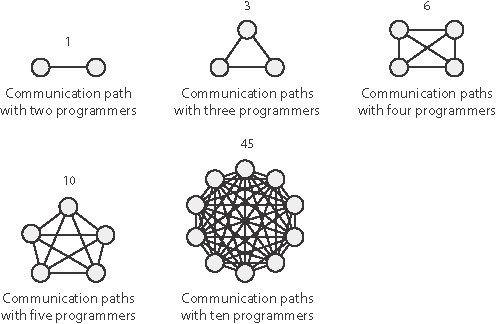- Code Complete, Second Edition
- Preface
- Acknowledgments
- About the Author
- I. Laying the Foundation
- 1. Welcome to Software Construction
- 2. Metaphors for a Richer Understanding of Software Development
- 3. Measure Twice, Cut Once: Upstream Prerequisites
- 3.1. Importance of Prerequisites
- 3.2. Determine the Kind of Software You're Working On
- 3.3. Problem-Definition Prerequisite
- 3.4. Requirements Prerequisite
- 3.5. Architecture Prerequisite
- Typical Architectural Components
- Program Organization
- Major Classes
- Data Design
- Business Rules
- User Interface Design
- Resource Management
- Security
- Performance
- Scalability
- Interoperability
- Internationalization/Localization
- Input/Output
- Error Processing
- Fault Tolerance
- Architectural Feasibility
- Overengineering
- Buy-vs.-Build Decisions
- Reuse Decisions
- Change Strategy
- General Architectural Quality
- Typical Architectural Components
- 3.6. Amount of Time to Spend on Upstream Prerequisites
- Additional Resources
- Key Points
- 4. Key Construction Decisions
- II. Creating High-Quality Code
- 5. Design in Construction
- 5.1. Design Challenges
- 5.2. Key Design Concepts
- 5.3. Design Building Blocks: Heuristics
- Find Real-World Objects
- Form Consistent Abstractions
- Encapsulate Implementation Details
- Inherit—When Inheritance Simplifies the Design
- Hide Secrets (Information Hiding)
- Identify Areas Likely to Change
- Keep Coupling Loose
- Look for Common Design Patterns
- Other Heuristics
- Summary of Design Heuristics
- Guidelines for Using Heuristics
- 5.4. Design Practices
- 5.5. Comments on Popular Methodologies
- Additional Resources
- Key Points
- 6. Working Classes
- 7. High-Quality Routines
- 8. Defensive Programming
- 8.1. Protecting Your Program from Invalid Inputs
- 8.2. Assertions
- 8.3. Error-Handling Techniques
- 8.4. Exceptions
- 8.5. Barricade Your Program to Contain the Damage Caused by Errors
- 8.6. Debugging Aids
- 8.7. Determining How Much Defensive Programming to Leave in Production Code
- 8.8. Being Defensive About Defensive Programming
- Additional Resources
- Key Points
- 9. The Pseudocode Programming Process
- 5. Design in Construction
- III. Variables
- 10. General Issues in Using Variables
- 11. The Power of Variable Names
- 12. Fundamental Data Types
- 13. Unusual Data Types
- IV. Statements
- 14. Organizing Straight-Line Code
- 15. Using Conditionals
- 16. Controlling Loops
- 17. Unusual Control Structures
- 18. Table-Driven Methods
- 19. General Control Issues
- 19.1. Boolean Expressions
- Using true and false for Boolean Tests
- Making Complicated Expressions Simple
- Forming Boolean Expressions Positively
- Using Parentheses to Clarify Boolean Expressions
- Knowing How Boolean Expressions Are Evaluated
- Writing Numeric Expressions in Number-Line Order
- Guidelines for Comparisons to 0
- Common Problems with Boolean Expressions
- 19.2. Compound Statements (Blocks)
- 19.3. Null Statements
- 19.4. Taming Dangerously Deep Nesting
- 19.5. A Programming Foundation: Structured Programming
- 19.6. Control Structures and Complexity
- Key Points
- 19.1. Boolean Expressions
- V. Code Improvements
- 20. The Software-Quality Landscape
- 21. Collaborative Construction
- 22. Developer Testing
- 23. Debugging
- 24. Refactoring
- 25. Code-Tuning Strategies
- 26. Code-Tuning Techniques
- VI. System Considerations
- 27. How Program Size Affects Construction
- 28. Managing Construction
- 29. Integration
- 30. Programming Tools
- VII. Software Craftsmanship
- 31. Layout and Style
- 32. Self-Documenting Code
- 32.1. External Documentation
- 32.2. Programming Style as Documentation
- 32.3. To Comment or Not to Comment
- 32.4. Keys to Effective Comments
- 32.5. Commenting Techniques
- 32.6. IEEE Standards
- Additional Resources
- Key Points
- 33. Personal Character
- 33.1. Isn't Personal Character Off the Topic?
- 33.2. Intelligence and Humility
- 33.3. Curiosity
- 33.4. Intellectual Honesty
- 33.5. Communication and Cooperation
- 33.6. Creativity and Discipline
- 33.7. Laziness
- 33.8. Characteristics That Don't Matter As Much As You Might Think
- 33.9. Habits
- Additional Resources
- Key Points
- 34. Themes in Software Craftsmanship
- 34.1. Conquer Complexity
- 34.2. Pick Your Process
- 34.3. Write Programs for People First, Computers Second
- 34.4. Program into Your Language, Not in It
- 34.5. Focus Your Attention with the Help of Conventions
- 34.6. Program in Terms of the Problem Domain
- 34.7. Watch for Falling Rocks
- 34.8. Iterate, Repeatedly, Again and Again
- 34.9. Thou Shalt Rend Software and Religion Asunder
- Key Points
- 35. Where to Find More Information
- Bibliography
- Index
- About the Author
Related Topics
Prerequisites to construction: Chapter 3
Determining the kind of software you're working on: Determine the Kind of Software You're Working On
Managing construction: Chapter 28
Scaling up in software development isn't a simple matter of taking a small project and making each part of it bigger. Suppose you wrote the 25,000-line Gigatron software package in 20 staff-months and found 500 errors in field testing. Suppose Gigatron 1.0 is successful, as is Gigatron 2.0, and you start work on the Gigatron Deluxe, a greatly enhanced version of the program that's expected to be 250,000 lines of code.
Even though it's 10 times as large as the original Gigatron, the Gigatron Deluxe won't take 10 times the effort to develop; it'll take 30 times the effort. Moreover, 30 times the total effort doesn't imply 30 times as much construction. It probably implies 25 times as much construction and 40 times as much architecture and system testing. You won't have 10 times as many errors either; you'll have 15 times as many—or more.
If you've been accustomed to working on small projects, your first medium-to-large project can rage riotously out of control, becoming an uncontrollable beast instead of the pleasant success you had envisioned. This chapter tells you what kind of beast to expect and where to find the whip and chair to tame it. In contrast, if you're accustomed to working on large projects, you might use approaches that are too formal on a small project. This chapter describes how you can economize to keep a small project from toppling under the weight of its own overhead.
If you're the only person on a project, the only communication path is between you and the customer, unless you count the path across your corpus callosum, the path that connects the left side of your brain to the right. As the number of people on a project increases, the number of communication paths increases, too. The number doesn't increase additively as the number of people increases. It increases multiplicatively, proportionally to the square of the number of people, as illustrated in Figure 27-1.
Figure 27-1. The number of communication paths increases proportionate to the square of the number of people on the team
As you can see, a two-person project has only one path of communication. A five-person project has 10 paths. A ten-person project has 45 paths, assuming that every person talks to every other person. The 10 percent of projects that have 50 or more programmers have at least 1,200 potential paths. The more communication paths you have, the more time you spend communicating and the more opportunities are created for communication mistakes. Larger-size projects demand organizational techniques that streamline communication or limit it in a sensible way.
The typical approach taken to streamlining communication is to formalize it in documents. Instead of having 50 people talk to each other in every conceivable combination, 50 people read and write documents. Some are text documents; some are graphic. Some are printed on paper; others are kept in electronic form.
-
No Comment


